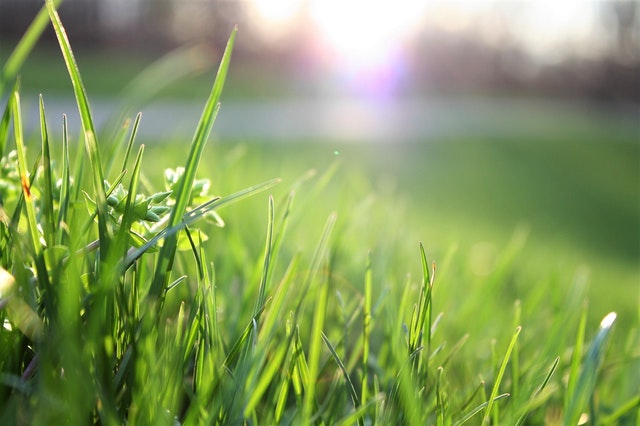
Keeping your lawn neat and tidy can sometimes feel like a bit of a chore, but it's a job worth doing if you want to make the most out of your outdoor space.
Now that spring has arrived, you'll likely be spending a lot more time in the garden - so now is the perfect time to brush up on your lawn maintenance knowledge!
If you want your lawn to look its best, here are 10 things to put on your springtime to-do list...
1. Get rid of weeds
Weeds can spoil your lawn's appearance and rob your grass of all-important moisture and nutrients. No matter how diligent you are with your lawn maintenance routine, it will all be for naught if you allow weeds to grow unchecked!
There are all sorts of anti-weed products available in shops, but very often, these commercial weedkillers only provide a short-term solution. The important thing is to address the conditions that allowed the weeds to appear in the first place; to that end, it may be best to hire a professional weed control specialist who uses broad-spectrum systemic herbicides that aren't available to the general public.
READ MORE: Our Weed Control Service
2. Clear your lawn of moss and thatch
Moss and thatch can seriously stymie your lawn's ability to grow. We recommend applying moss control products, followed by a round of scarification two or three weeks later.
Scarification involves pulling dead moss and thatch out of your lawn with a rake or a specially-designed scarification machine. It's important to apply moss killer first - if you don't, scarification may spread moss spores around and intensify your lawn's moss problem.
READ MORE: When to Scarify Your Lawn
3. Improve your lawn's drainage
'Drainage' means how quickly water disappears from your lawn, for example after a rain shower. Poor drainage can keep your lawn waterlogged for ages after the rain's stopped, and this is bad news for the health of your grass.
There are a number of ways to improve drainage, from aeration (see tip 5 below) to digging a series of trenches in your lawn. If you need help with this, we recommend reading our blog on how to prevent waterlogging.
READ MORE: Dealing with a Waterlogged Lawn
4. Mow your lawn regularly
Mowing is a crucial part of any lawn maintenance schedule. You should try to mow at least once a week (and twice in the summertime, since warm and sunny weather will make your grass grow faster).
Don't cut your grass shorter than an inch and a half. When mowing, remember the one-third rule: never cut off more than a third of your grass's height in a single mowing session.
READ MORE: Lawn Mowing Tips
5. Combat soil compaction by aerating
The more you walk on your lawn, the more the soil will become compacted (pushed together). Heavy rain can also accelerate compaction.
Heavily-compacted soil makes it harder for moisture and oxygen to reach the roots of your grass, so it's important to aerate your lawn every few years by 'spiking' holes into the soil. This can be done using a garden fork, but we use professional aeration machines to loosen your garden soil - it's far more efficient!
READ MORE: Our Soil Aeration Service
6. Consider top-dressing your lawn
Top-dressing is the practice of adding nutrients to your lawn to improve the quality of the soil over time. This can be particularly beneficial if you live in an area with clay-heavy soil or thin, sandy soil.
Top-dressing isn't a 'one and done' type of job; to achieve the best possible results, several layers must be applied over a period of time. If done properly, this will gradually change the properties of your soil and create better growing conditions for your grass.
READ MORE: Our Top-Dressing Service
7. Overseed sparse patches
If your lawn has several thinned-out patches of unhealthy-looking grass, overseeding may be the key to improving its appearance. This is the practice of adding new grass seeds to a lawn to replace dead grass and restore lost thickness.
We recommend overseeding your lawn every three years or so as part of a longer-term lawn maintenance programme. For optimum results, do this after scarifying, aerating and top-dressing your lawn as described above.
READ MORE: What is Overseeding?
8. Make sure your lawn gets plenty of water
It's not really necessary to water your lawn as long as the grass is getting plenty of moisture from frequent rain showers. However, since spring is here and another hot, dry summer is no doubt on its way, you may soon have to put a bit of work in yourself to compensate for the reduced rainfall.
We recommend a heavy watering once or twice a week. Don't water too often, as this will encourage the roots of your grass to stay near the surface of the soil, making your lawn weaker and diminishing its drought resistance.
READ MORE: Lawn Watering Tips
9. Keep your lawn well fed
You'll find lots of lawn fertiliser products in your local supermarket. A spring lawn feed needs to be rich in nutrients to give your lawn everything it needs for a period of vigorous, accelerated growth.
Again, it may a good idea to call a professional in to administer a specially-chosen spring lawn feed and make sure your lawn is well prepared for the months ahead.
READ MORE: Our Spring Lawn Treatment
10. Tidy up the edges
Finally, if you're keen to make your lawn look as neat as possible, you may want to use a pair of long-handled shears to cut around the perimeter of your lawn and make sure the grass isn't growing into your borders.
If you'd rather leave your lawn maintenance to the professionals, we at Lawn & Weed Expert can help! Give us a call on 0800 111 4958 or email sales@lawnweedexpert.co.uk today.
Book a FREE Lawn Survey >>
Photo from Pexels.com